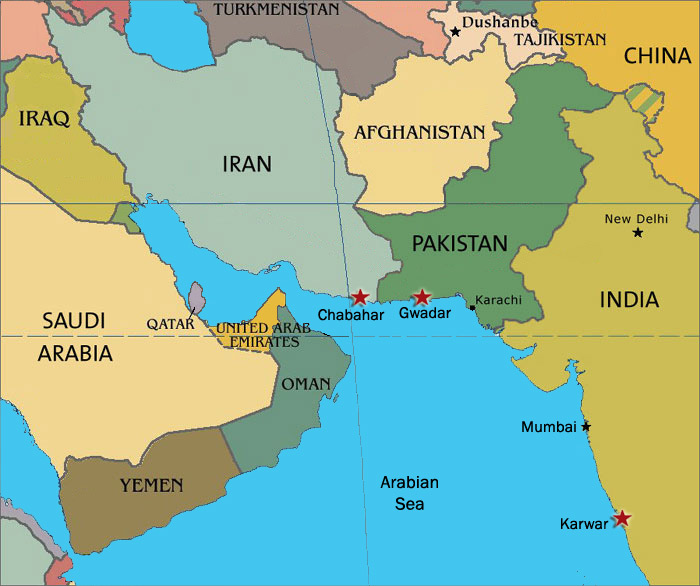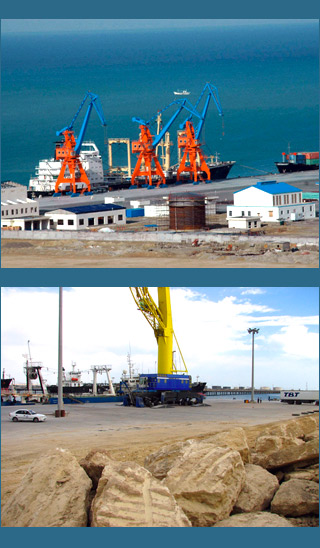New
PDF THINK TANK: ANALYST

- Joined
- Jul 9, 2012
- Messages
- 2,023
- Reaction score
- 8
- Country
- Location


The Great Game redux: China and India maneuver over Arabian Sea ports, Gwadar (top) and Chabahar (below)
Both Pakistan and Iran being close neighbours have cordial and fraternal relations with each other. Both have evolved master plan to create economic, trade and transport ties with Central Asian countries, Afghanistan and beyond. The two countries have offered all sorts of facilities and generous incentives to shipping companies and other countries of the world to do business in their respective ports. For Central Asian countries, both the ports are most likely to become major link to global market.
Construction of Gwadar Port was necessitated due to the fact that Karachi Port was already heavily-loaded with serious congestion from commercial, fishing, civil and military shipping. It may be recalled that in 1971, the Indian Navy targeted the Karachi Port leading to a massive harm to the economy of Pakistan. It was felt that any future blockade by India would further devastate Karachi Port and economy of the country. In order to relieve too much reliance on the Karachi Port, another port by the name Port Qasim was established in Karachi. Now, with the establishment of Gwadar Port in the province of Balochistan the reliance on Karachi Port will be further reduced.
Port of Bandar Abbas in Iran is of strategic importance as it is situated on the Strait of Hurmuz leading to the Persian Gulf. This is problematic for Iran because of the high traffic and probably the penetrations of US Navy. To be more secure, the Iranians established Port of Chabahar for more congenial trade with other countries. They foresee that Chabahar Port as an instrument in their policy to escape international isolation. Iranian officials state that they desire to have Bandar Abbas Port remain as the port for Russian and European trade.
Chabahar Port is situated on the Makran Coast of the Sistan and Balochistan of Iran and is officially declared as a free trade and industrial zone by the Iranian government. The port has been developed by India. It is the closest and best access point to the Indian Ocean. Its location is at the most secure and closet route to Central Asia and Afghanistan market. It has proximity to the largest energy resources of the world. Its economic sectors are fishery industries and commercial. The port is well-connected to other cities of the country by road and airlines. A strategic partnership will be established between Iran, India and Russia to establish a multi-model transport link connecting Mumbai with Saint Petersburg, providing Europe and the former Soviet Union Republics of Central Asia access to Asia and vice versa. Iran and Afghanistan have signed an agreement to give Indian goods leading for Central Asia and Afghanistan, preferential treatment and tariff reduction at Chabahar Port.
The berths in Port of Chabahar include general cargo and bulk. Berth capacities range from 2,000 to 2,500 tonnes. Chabahar Shahid Beheshti Jetty has a length of 600 metres and can berth four vessels of up to 25,000 gross tonnage and 11-metre draught simultaneously. The other Shahid Kalantary Jetty has a length of 1100 metres, four metallic ready-made jetties. Adequate reserves of water and electricity efficient telecommunication network, warehouses and cold storage facilities are already available.
Gwadar Port is located on the Gulf of Oman, close to the entrance of Persian Gulf. It is a deep warm water sea port, about 460-kilometer west of Karachi and approximately 75-kilometer east of Pakistan border with Iran. The port is close to the important Strait of Hormuz, through which more than 13 million bpd of oil passes. It is strategically between the oil-rich Middle East, the economically shortest route to the oil-rich Central Asian States through land-locked Afghanistan, and heavily populated South Asia. It is at the mouth of the Gulf through which 40 per cent of world's daily oil passes. Much of it has been financed by China. At present, the project is estimated to be $1 billion or even more. In 2007, the government of Pakistan handed over the operations of port to PSA, Singapore for 25 years and gave the status of a Tax-Free Port for 40 years. The port became somewhat a little bit functional in 2008 with first ship to dock bringing 52,000 tonnes of wheat from Canada.
Gwadar Port has the capacity to handle large crude containers of up to 500,000 tonnes deadweight. It will have three containers terminal, a bulk- cargo terminal, a grain terminal and an oil terminal. It would promote economic development in the country and would provide vast employment opportunities to the Baloch people. The establishment of Free-Trade and Economic Zones and Export Processing Zone would attract foreign investment, and employment opportunities to the local people. The port will not open large avenues for the people of Mekran engaged in fishing and agriculture but will also facilitate easier transportation of date export to foreign markets. Gwadar would generate massive revenues for the Balochistan province. It would become a trade hub, once road and rail links are linked to the rest of Pakistan, Afghanistan and Central Asia. Pakistan has future plan for development of Gwadar to cater foreign trade of the Central Asian Republics and the Xingjian and the Sichuan provinces and the Tibetan region of China. It also proposes the construction of a rail and road network between Gwadar and Xingjian.
Gwadar Port will have to face stiff competition from Chabahar. It is still not operating vigorously as Chabahar. The supporting structures at Gwadar Port are still not existent. Two years have passed away and there is no visible economic activity in this port. Several projects such as 950-km railway and 900-km motorway to link with railway and highway of the country have so far remained only in files. The 200-km branch road which would link coastal road to the Indus Highway at Ratto-Dero is still not developed. There are no internal roads and services and water, gas, power and communication services for the new township and industrial zone. There are no warehouses and cold storages there.
India's financing and engineering assistance is not only limited to Chabahar Port but it is also actively developing a highway that leads from the Chabahar Port to Afghanistan. Chabahar Port is well-suited for linking southern ports of Afghanistan and a few Central Asian States. For Pakistan in the present condition the Southern Afghanistan is not ready to be a reliable transport corridor for Pakistan access to Central Asian states. Gwadar Port can be operated efficiently if there is no kidnapping and deadly attacks on foreigners and the government of Pakistan makes favorable concessions to Baloch people living in Gwadar and its surrounding areas.
As long as peace and tranquility prevails in the region and there is no cutthroat competition between Chabahar and Gwadar ports and India does not unduly interfere in the affairs of Balochistan by supporting the insurgency there the Gwadar Port trading activities will be accelerated. Further, the current confirmed involvement of terrorism activities by India in Swat and tribal areas and rising Indian economic and political influence in Afghanistan would exacerbate the tension in the region and would harm the normal activities of the Gwadar Port.
With the full operation of Gwadar Port, there are bright prospects for Balochistan for attaining on economic par with other provinces of Pakistan. The real value of Gwadar Port could be witnessed when Chinese trade grows with Gulf States, Middle East and European countries. Any transport or defense problems in the Strait of Malacca, the Strait of Hurmuz and the Suez will promote the significance of Central Asia as a strategic trade corridor. China, Iran and India are desperate in having closer ties with Afghanistan and Central Asian states. Iran's main considerations are not only boosting trade but securing its borders and avoiding American Navy in this region. Pakistan wants peace in its region and it does not want that militants spoil further its economy and it hopes for the best relations with Afghanistan and Central Asian states. According to the Iranian officials, both Chabahar and Gwadar can equally benefit from Central Asian business.
Conclusion
The countries of Central Asia will likely benefit from both Chabahar and Gwadar. Diversifying its import and export routes is a logical economic and political step. Although one should not exaggerate the economic benefits to be reaped. As for the competition between the two ports, it will not be a “winner take all” outcome but rather one port earning the greater share of trade. And the “winner” in this respect will likely be Chabahar, at least in the short term. Iran is more stable than Pakistan, it has better relations with Afghanistan and the Central Asian states, and unlike the Gwadar route its proposed route goes through relatively stable parts of Afghanistan. As long as Iran avoids outright conflict with the United States or any sort of domestic turmoil it should come out of this competition with an advantage.
For further readings;
Central Asia’s Seaport: Gwadar or Chabahar? — Registan.net
Chabahar Versus Gwadar | The Pakistani Spectator
Their Gwadar, Our Chabahar
Chahbahar and Gwadar





